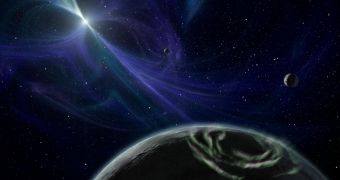Astronomers believe that they may have found a new way to look for a specific type of extrasolar planets, namely those that orbit special types of neutron stars called pulsars. These so-called pulsar planets may leave behind an electric signature as they move around their parent stars.
Neutron stars are the imploded core of massive progenitor stars, at least 8 times heavier than the Sun. If these objects are not large enough to collapse into a black hole when they go supernova, they form a neutron star, an object that releases massive amounts of particles called neutrons.
A single teaspoon of material from such a star would weigh more than the entire Himalayas, or around 100 million tons, that's how dense the object is. A pulsar is a special kind of neutron star in the sense that it releases massive jets of radiations as it spins.
Sometimes, these jets can be seen head-on from Earth, appearing and disappearing at regular intervals. Early astronomers saw this pulsating light, and likened it to that released by a lighthouse, hence the name. Pulsars store the mass of the Sun in a sphere around 32 kilometers (20 miles) wide.
Thus far, experts only managed to discover two pulsar systems that contain exoplanets in orbit, out of more than 780 planets identified thus far, and 2,300+ candidates. An analysis of the two systems reveals that the planets in orbit may be producing electric anomalies as they travel in orbit.
The existence of planets around pulsars is a mystery in itself, since the very existence of such a star involves that any exoplanet must survive a supernova explosion occurring in its immediate vicinity, explains Paris Observatory astronomer and astrophysicist, Fabrice Mottez.
He and his team believe that exoplanets orbiting pulsars would interact with the electrical fields produced by the stars, and create anomalies in their wake, which could be detected even from Earth.
“In some circumstances, these currents would be almost as strong as those directly generated by the pulsar,” the researcher tells Space. He adds that these swirling currents should also generate a series of detectable radio emissions.
At this time, scientists are testing to see whether or not it's possible to detect these planets by scanning for their radio signatures. There are currently several high-performance radio telescopes available for this type of study, and experts will check if they can see the distant worlds.
Details of the new study were presented on September 28, at the annual 2012 European Planetary Science Congress, held in Madrid, Spain.

 14 DAY TRIAL //
14 DAY TRIAL //